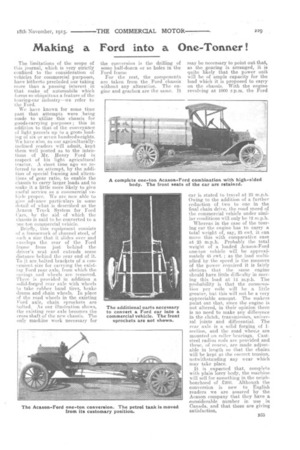Making a Ford into a One-Tonner !
Page 9

If you've noticed an error in this article please click here to report it so we can fix it.
The limitations of the scope of this journal, which is very strictly confined to the consideration of vehicles for commercial purposes, have hitherto precluded our taking more than a passing interest in that make of automobile which forms so ubiquitous a feature of the touring-car industry—we refer to the Ford,
We have known for some time past that attempts were being made to utilize this chassis for goods-carrying purposes ; this in addition to that of the conveyance of light parcels up to a gross loading of six or seven hundredweights. We have also, as our agriculturallyinclined readers will admit, kept them well posted as to the intentions of Mr. Henry Ford in respect of his light agricultural tractor. A short time ago we referred to an attempt, by the addition of special framing and alterations of gear ratio, to enable the chassis to carry larger loads and to make it a little more likely to give useful service as a commercial vehicle proper. We are now -able to give advance particulars in some detail of what is described as the Acason Truck System for Ford Cars, by the aid of which the chassis is said to be converted to a 'me-ton commercial vehicle.
Briefly, this equipment, consists of a framework of channel steel, of such a size that it slides over and envelops the rear of the Ford frame from just behind the driver's seat and extends some distance behind the rear end of it. To it are bolted brackets of a convenient size for carrying the existing Ford rear axle from which the springs and wheeis are removed. There is provided in addition a solid-forged rear axle with wheels to take rubber band tires, brake drums and chain wheels. In place of the road wheels in the existing Ford axle, chain sprockets are bolted. As our illustration shows, he existing rear axle becomes the cross shaft of the new chassis. The only machine work necessary for the conversion is the drilling of some half-dozen or so holes in the Ford frame
For the rest, the components are taken from the Ford chassis without any alteration. The engine and gearbox are the same. It
may be necessary to point out that, as the gearing is arranged, it is quite likely that the power unit will be of ample capacity for the load which it is proposed to carry on the chassis. With the engine revolving at 1000 r.p.rn. the Ford
ear is stated to travel at 25 m.p.h. Owing to the addition of a further reduction Of two to one in the final chain drive, the road speed of the commercial vehicle under similar conditions will only be 12 m.p.h.
Whereas in the case of the touring car the engine has to carry a total weight of, say, 25 cwt. it can move this with comparative ease at 25 m.p.h. Probably the total weight of a loaded Acason-Ford one-ton vehicle will be approxi mately 45 cwt. ; as the load multiplied by the speed is the measure of the power required it is fairly obvious that the same engine should have little difficulty in moving this load at 14 m.p.h. The probability is that the Consumption per mile will be a little greater, hut. this will not be a very appreciable amount. The makers point out that, since the engine is not altered, in their opinion there is no need to make any difference in the clutch, transmission, universal joints and differential. The rear axle is a solid forging of 1section, and the road wheels are mounted on roller bearings. Caststeel radius rods are provided and these, of course, are made adjustable in length so that the chains will be kept at the correct tension, notwithstanding any wear which may take place.
It is expected that, complete with plain lorry body, the machine will sell for something in the neighbourhood of £200. Although the conversion is new tb English readers we are assured by the Aca.son company that they have a considerable number in use in Canada, and that these are giving satisfaction.






















